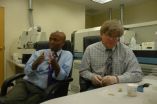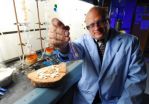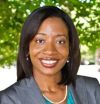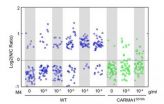Genetic study confirms link between earliest Americans and modern Native-Americans
Research sheds light on first people of the Americas
2014-05-15
(Press-News.org) AUSTIN, Texas — The ancient remains of a teenage girl found in an underwater Mexican cave establish a definitive link between the earliest Americans and modern Native Americans, according to a new study released today in the journal Science.
The study was conducted by an international team of researchers from 13 institutions, including Deborah Bolnick, assistant professor of anthropology at The University of Texas at Austin, who analyzed DNA from the remains simultaneously with independent researchers at Washington State University and the University of Illinois at Urbana-Champaign.
The findings have major implications for our understanding of the origins of the Western Hemisphere’s first people and their relationship to contemporary Native Americans.
The most ancient human remains in the Americas have baffled scientists because their skulls are narrower and have other measurably different features from those of Native Americans. Some researchers have hypothesized that these individuals came to the Americas from as far away as Australia, Southeast Asia or Europe.
Bolnick and her colleagues Brian Kemp of Washington State University and Ripan Malhi of the University of Illinois at Urbana-Champaign analyzed the DNA from the tooth of the adolescent girl who fell into a sinkhole in Mexico’s Yucatán Peninsula more than 12,000 years ago. The remains were found surrounded by a variety of extinct animals more than 130 feet below sea level in Hoyo Negro, a deep pit within the Sac Actun cave system in the Yucatán.
In three separate labs, the researchers independently examined the tooth’s mitochondrial DNA, which is maternally inherited (passed down from mother to child).
Each of the labs found that the ancient girl belonged to a genetic lineage shared only by Native Americans. This is the first time researchers have been able to match a skeleton with an early American (or Paleoamerican) skull and facial characteristics with DNA linked to the hunter-gatherers who moved onto the Bering Land Bridge from northeast Asia between 26,000 and 18,000 years ago, spreading southward into North America sometime after 17,000 years ago.
“The Hoyo Negro girl was related to living Native Americans and has ancestry from the same Beringian population,” Bolnick says. “This study therefore provides no support for the hypothesis that Paleoamericans migrated from Southeast Asia, Australia or Europe. Instead, it shows that Paleoamericans could have come from Beringia, like contemporary Native Americans, even though they exhibit some distinctive skull and facial features. The physical differences between Paleoamericans and Native Americans today are more likely due to changes that occurred in Beringia and the Americas over the last 9,000 years.”
The study was led by Mexico’s National Institute of Anthropology and History, and coordinated by James Chatters, owner of Applied Paleoscience, an archaeological and paleontological consulting firm in Bothell, Wash.
The Hoyo Negro expedition will be featured in National Geographic magazine and on a National Geographic Television program airing on the PBS series “Nova” in 2015.
INFORMATION:
For more information, contact: Jessica Sinn, College of Liberal Arts, Office of Public Affairs, 512-471-2404, sinnjessica@gmail.com; Deborah Bolnick, Department of Anthropology, 512-471-7532, deborah.bolnick@austin.utexas.edu END
ELSE PRESS RELEASES FROM THIS DATE:
First 'heavy mouse' leads to first lab-grown tissue mapped from atomic life
2014-05-15
Scientists have created a 'heavy' mouse, the world's first animal enriched with heavy but non-radioactive isotopes - enabling them to capture in unprecedented detail the molecular structure of natural tissue by reading the magnetism inherent in the isotopes.
This data has been used to grow biological tissue in the lab practically identical to native tissue, which can be manipulated and analysed in ways impossible for natural samples. Researchers say the approach has huge potential for scientific and medical breakthroughs: lab-grown tissue could be used to replace heart ...
One of oldest human skeletons in North America is discovered
2014-05-15
Cave-diving scientist Patricia A. Beddows of Northwestern University is a member of an international team of researchers and cave divers this week announcing the discovery in an underwater Yucatán Peninsula cave of one of the oldest human skeletons found in North America.
Details of "Naia," a teenage girl who went underground to seek water and fell to her death in a large pit named Hoyo Negro ("black hole" in Spanish), will be published May 16 in the journal Science.
"The preservation of all the bones in this deep water-filled cave is amazing -- the bones are beautifully ...
Communicating with the world across the border
2014-05-15
Stanford, CA—All living cells are held together by membranes, which provide a barrier to the transport of nutrients. They are also the communication platform connecting the outside world to the cell’s interior control centers. Thousands of proteins reside in these cell membranes and control the flow of select chemicals, which move across the barrier and mediate the flux of nutrients and information. Almost all of these pathways work by protein handshakes--one protein “talking” to another in order to, for example, encourage the import of a needed nutrient, to block a compound ...
Quantum simulator gives clues about magnetism
2014-05-15
Assembling the puzzles of quantum materials is, in some ways, like dipping a wire hanger into a vat of soapy water, says CIFAR (Canadian Institute for Advanced Research) Fellow Joseph Thywissen (University of Toronto).
Long before mathematical equations could explain the shapes and angles in the soap foams, mathematicians conjectured that soap films naturally found the geometry that minimized surface area, thus solving the problem of minimal surfaces. They could be created simply by blowing soap bubbles.
At the University of Toronto's Ultracold Atoms Lab, Thywissen ...
UNM plays major role in establishing link between ancient and modern Native-Americans
2014-05-15
Her name is Naia, and for thousands and thousands of years, the skeleton of this young woman was buried underwater in an elaborate cave system in the Yucatan Peninsula after she had apparently fallen into what was then a dry deep pit.
Now, a team of researchers, including Professor Yemane Asmerom and Research Scientist Victor Polyak at the University of New Mexico's Department of Earth and Planetary Sciences, have accurately determined the age of the oldest-known, well-preserved human skeleton. Naia was one of the earliest inhabitants of the Americas and has helped resolve ...
Making money from lignin: Roadmap shows how to improve lignocellulosic biofuel biorefining
2014-05-15
When making cellulosic ethanol from plants, one problem is what to do with a woody agricultural waste product called lignin. The old adage in the pulp industry has been that one can make anything from lignin except money.
A new review article in the journal Science points the way toward a future where lignin is transformed from a waste product into valuable materials such as low-cost carbon fiber for cars or bio-based plastics. Using lignin in this way would create new markets for the forest products industry and make ethanol-to-fuel conversion more cost-effective.
"We've ...
UH researchers find definitive evidence of how zeolites grow
2014-05-15
Researchers have found the first definitive evidence of how silicalite-1 (MFI type) zeolites grow, showing that growth is a concerted process involving both the attachment of nanoparticles and the addition of molecules.
Both processes appear to happen simultaneously, said Jeffrey Rimer, an engineering professor at the University of Houston and lead author of a paper published Thursday in the journal Science.
He said a second component to the research could have even more lasting impact. He and researcher Alexandra I. Lupulescu used a new technique allowing them to view ...
Anti-craving drug and counseling lower alcohol harm in homeless, without sobriety demands
2014-05-15
Chronically homeless, alcohol-dependent individuals might benefit from a new intervention that does not require them to stop or even reduce drinking, according to the results of a preliminary study in Seattle.
Participants in the 12-week pilot program received monthly injections of an anti-craving medication, extended-release naltrexone. They also met regularly with study physicians to set their own goals for treatment and to learn to be safer in their use of alcohol.
"Abstinence-based alcohol treatment has not been effective for or desirable to many homeless people ...
UTHealth research: Children of parents in technical jobs at higher risk for autism
2014-05-15
HOUSTON – (May 15, 2014) – Children of fathers who are in technical occupations are more likely to have an autism spectrum disorder, according to researchers at The University of Texas Health Science Center at Houston (UTHealth).
The findings will be presented Friday at the International Meeting for Autism Research in Atlanta.
During participation in the LoneStar LEND program, first author Aisha S. Dickerson, Ph.D., a researcher at UTHealth's Center for Clinical and Translational Sciences, used the United States government's Standard Occupational Classification system. ...
B cells produce antibodies 'when danger calls, but not when it whispers'
2014-05-15
The immune system's B cells protect us from disease by producing antibodies, or "smart bullets," that specifically target invaders such as pathogens and viruses while leaving harmless molecules alone. But how do B cells determine whether a threat is real and whether to start producing these weapons?
An international team of life scientists shows in the May 16 issue of the journal Science how and why these cells respond only to true threats.
"It is critical for B cells to respond either fully or not at all. Anything in between causes disease," said the study's senior ...
LAST 30 PRESS RELEASES:
Numbers in our sights affect how we perceive space
SIMJ announces global collaborative book project in commemoration of its 75th anniversary
Air pollution exposure and birth weight
Obstructive sleep apnea risk and mental health conditions among older adults
How talking slows eye movements behind the wheel
The Ceramic Society of Japan’s Oxoate Ceramics Research Association launches new international book project
Heart-brain connection: international study reveals the role of the vagus nerve in keeping the heart young
Researchers identify Rb1 as a predictive biomarker for a new therapeutic strategy in some breast cancers
Survey reveals ethical gaps slowing AI adoption in pediatric surgery
Stimulant ADHD medications work differently than thought
AI overestimates how smart people are, according to HSE economists
HSE researchers create genome-wide map of quadruplexes
Scientists boost cell "powerhouses" to burn more calories
Automatic label checking: The missing step in making reliable medical AI
Low daily alcohol intake linked to 50% heightened mouth cancer risk in India
American Meteorological Society announces Rick Spinrad as 2026 President-Elect
Biomass-based carbon capture spotlighted in newly released global climate webinar recording
Illuminating invisible nano pollutants: advanced bioimaging tracks the full journey of emerging nanoscale contaminants in living systems
How does age affect recovery from spinal cord injury?
Novel AI tool offers prognosis for patients with head and neck cancer
Fathers’ microplastic exposure tied to their children’s metabolic problems
Research validates laboratory model for studying high-grade serous ovarian cancer
SIR 2026 delivers transformative breakthroughs in minimally invasive medicine to improve patient care
Stem Cell Reports most downloaded papers of 2025 highlight the breadth and impact of stem cell research
Oxford-led study estimates NHS spends around 3% of its primary and secondary care budget on the health impacts of heat and cold in England
A researcher’s long quest leads to a smart composite breakthrough
Urban wild bees act as “microbial sensors” of city health.
New study finds where you live affects recovery after a hip fracture
Forecasting the impact of fully automated vehicle adoption on US road traffic injuries
Alcohol-related hospitalizations from 2016 to 2022
[Press-News.org] Genetic study confirms link between earliest Americans and modern Native-AmericansResearch sheds light on first people of the Americas







